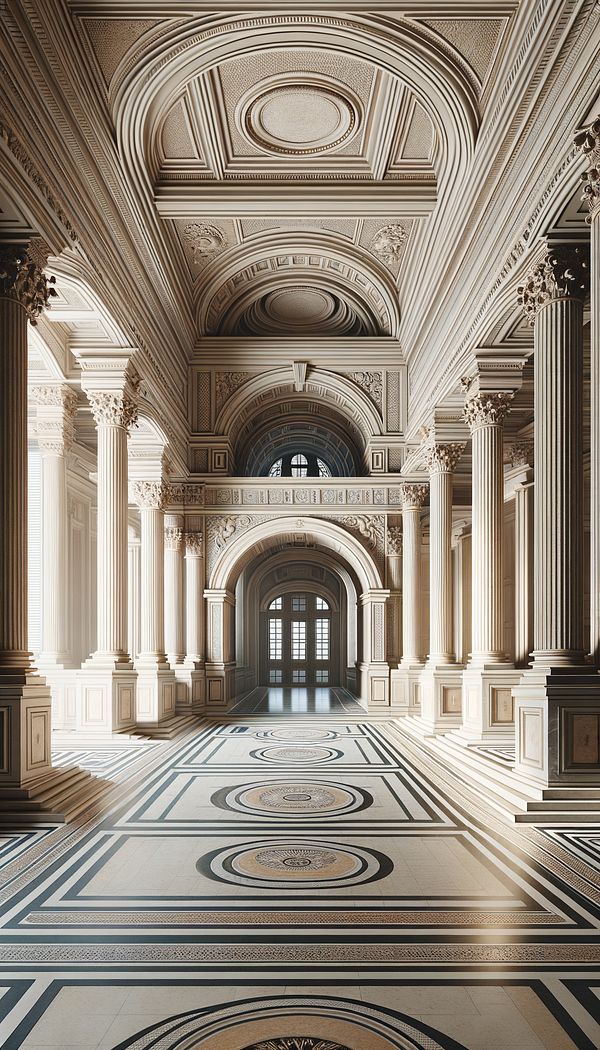What is Palladian?
Palladian is an architectural and interior design style characterized by symmetry, perspective, and classical forms.
Description
Palladian design, a term coined after the Italian architect Andrea Palladio, is a style rooted in the principles of classical architecture from ancient Rome and Greece. Palladian architecture is renowned for its emphasis on symmetry, perspective, and the utilization of classical forms such as columns and pediments. This style made a significant impact during the Renaissance and found widespread popularity in Europe, especially England, in the 17th and 18th centuries.
The Palladian approach to design values balance and proportion above all, which can be seen in the precise arrangement of spaces and the harmonious relationship between individual elements within a building. In interior spaces, this translates to orderly layouts, the incorporation of grand archways, and the inclusion of detailed cornices and pilasters. The style often features a central hall or rotunda, flanked by symmetrically positioned rooms, providing both a sense of grandeur and harmony.
Despite its historical roots, Palladian design continues to influence contemporary architecture and interior design, thanks to its timeless appeal. It's appreciated not only for its aesthetic qualities but also for its thoughtful consideration of space, light, and function. Many modern buildings, seeking elegance and simplicity, draw inspiration from Palladian principles, integrating ancient motifs with modern materials and techniques.
Usage
Palladian design is often employed in grand public buildings like courthouses, museums, and educational institutions, as well as in opulent private residences. Its influence is also seen in smaller scale interior elements, such as furniture and decorative objects, that embrace symmetry and classical motifs.
FAQs
-
Who was Andrea Palladio?
Andrea Palladio was an Italian architect active in the 16th century, whose work and writings on architecture laid the groundwork for what would become known as Palladian design. His influence extended well beyond his lifetime, impacting architectural practices worldwide.
-
How does Palladian design differentiate from other classical architectural styles?
Palladian design is distinctive for its rigorous adherence to symmetry, perspective, and the incorporation of classical elements like columns and pediments in a harmonious manner. It aims for a balanced and rational aesthetic, taking inspiration directly from the architectural principles of ancient Rome and Greece.
-
Can Palladian design be applied to modern homes?
Absolutely! While Palladian design originates from classical architecture, its principles of symmetry, balance, and proportion can be seamlessly integrated into modern homes, offering a timeless and elegant aesthetic. Contemporary Palladian-inspired designs may feature simplified line work and a fusion of traditional motifs with modern materials.
Practical Application
To apply Palladian principles in interior design, focus on creating symmetrical layouts and incorporating classical elements such as columns, pilasters, and detailed cornices. Embrace balance and proportion in the arrangement of furniture and decor, and consider using archways or large windows to enhance the sense of space and light. Palladian design encourages thoughtful consideration of how each element relates to the whole, aiming for a cohesive and harmonious interior.
-
Architectural Elements199 articles
-
Design Styles478 articles
-
Historical Periods & Movements150 articles
-
Italian RenaissanceItalian Renaissance refers to the revival of classical art and architecture originating in Italy in the 14th century.
-
Bungalow StyleBungalow Style refers to a compact, single-story house design with distinct architectural features.
-
OrmoluOrmolu is a method of gilding that involves applying finely ground, high-carat gold to a bronze object.
-
X-StretcherAn X-Stretcher is a cross-shaped support structure found in furniture.
-
BailBail refers to a type of handle or pull on drawers, cabinets, or furniture.
